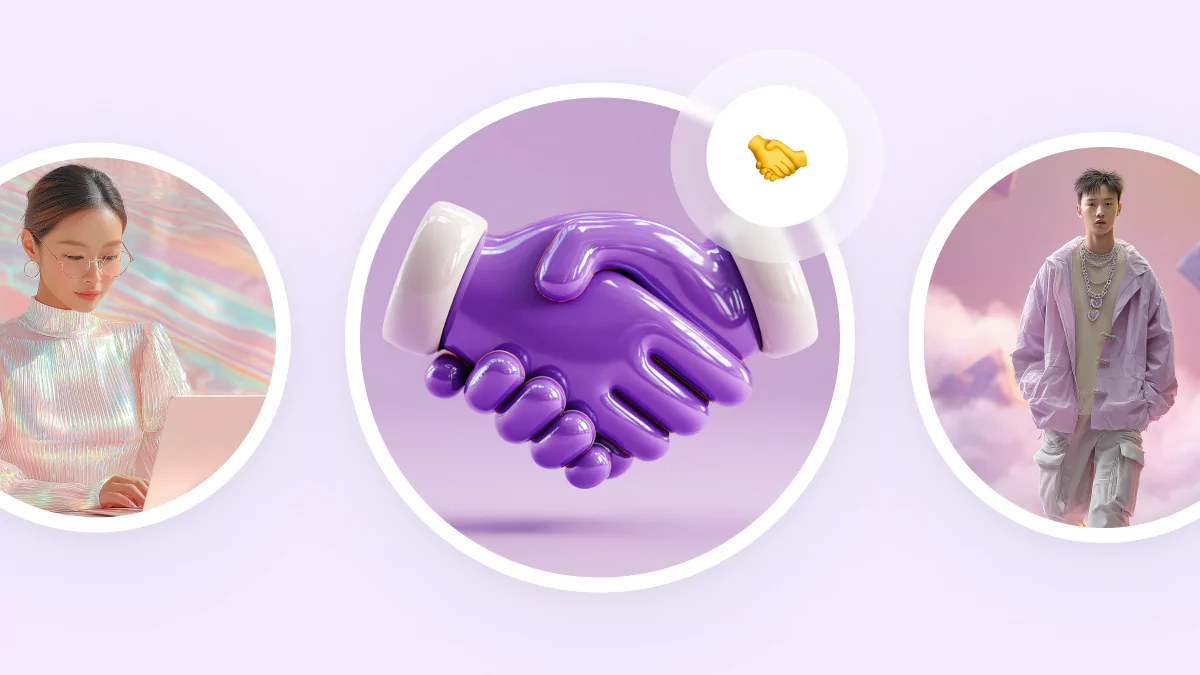
Influencer marketing is seen as an effective method to grow sales and influence buying decisions, which is the main reason more brands are willing to jump into the industry. According to Statista, influencer marketing usage in the US is expected to reach 86% in 2025. Meanwhile, another survey revealed that 86% of consumers make a purchase inspired by an influencer at least once per year. Just like that, the demand for influencers keeps skyrocketing.
However, recruiting influencers is just the beginning of an influencer marketing campaign. Once you decide on who to work with, the real challenge is collaborating and working toward campaign goals together. But that’s not all – to achieve them, brands and influencers need to be on the same page about almost everything. This is important to avoid ineffective campaigns and strained relationships.
The problem is, influencers and brands often stand on different grounds. Each side has its own expectations when it comes to collaboration, but more often than not, both parties fail to communicate them clearly; which leads to results that fall short.
In this piece, we’ll look at how to manage expectations in influencer marketing, so brands and influencers can better understand each other and learn how to get the most out of working together.
Understanding the perspectives of brands and influencers
Collaboration sounds simple until both sides bring different expectations to the table. Both influencers and brands want the same end result (a successful campaign), but the way they get there can be very different.
Based on The Creator Perspectives report by Influencer and Crowd DNA involving 500 content creators, there’s a clear disconnection between how creators and brands see a campaign’s goals. This helps us understand the key issues and make it easier to map their perspectives and figure out what can be done to bridge the gap.
Brands’ perspectives
Since brands invest budget, time, and strategy into a campaign, it’s natural for them to want control and focus on results. In general, these are things that matter most to them:
Brand image: They want influencer content to match the brand’s tone, language, and aesthetic.
Performance results: Measurable outcomes like clicks, conversions, or sales are top priorities.
Consistency: They expect influencers to follow brief, stick to deadlines, and avoid working with competitors at the same time.
Brand safety: They want to avoid controversies at all costs, so they tend to work with influencers who fit their values and have a clean reputation.
When asked about their top three measures of success for influencer marketing campaigns, marketers gave some interesting answers. 69% answered engagement rate, 53% said reach, and 43% said share of voice. These are followed by conversions, traffic, and sales, with each accounting for 30-35%. This proves that marketers press on performance metrics and expect them to be clearly reflected in influencer campaigns.
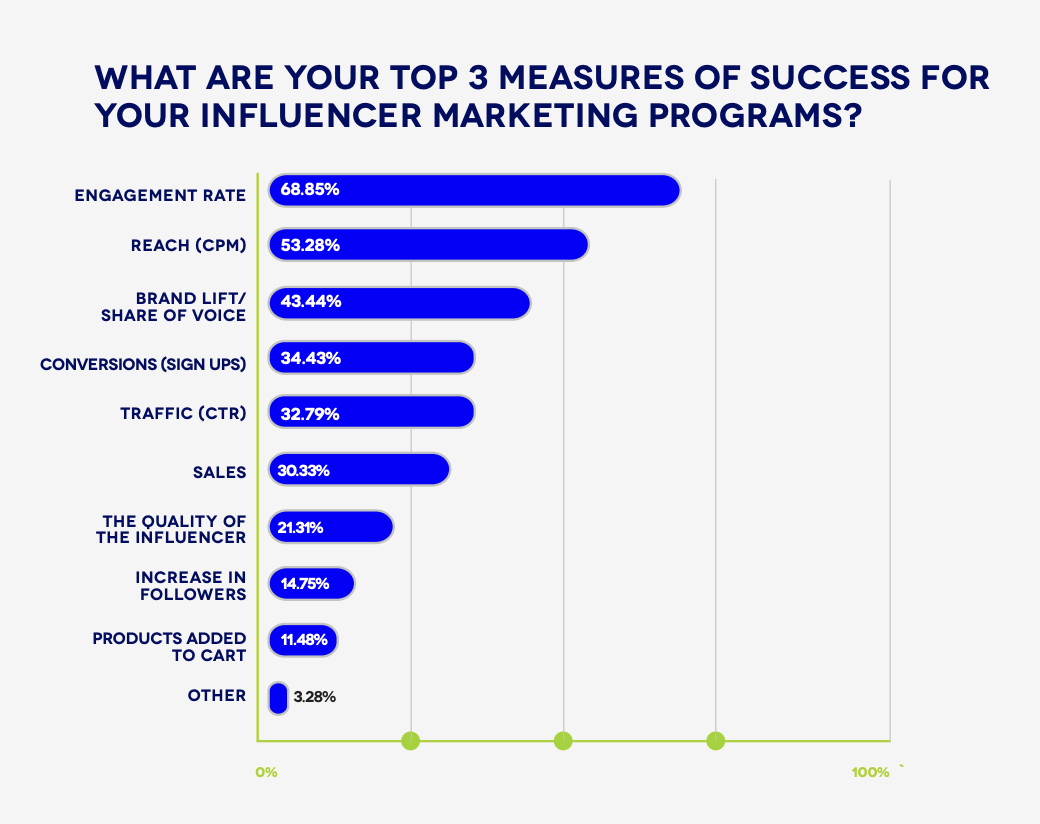 Image source: Linqia
Image source: Linqia
Influencers’ perspectives
The same report found that 56% of influencers prioritize engagement, 52% focus on content/creativity, 51% on follower growth, and 44% on reach. So, where does conversion stand? Only 30% of creators see it as a top priority for measuring success.
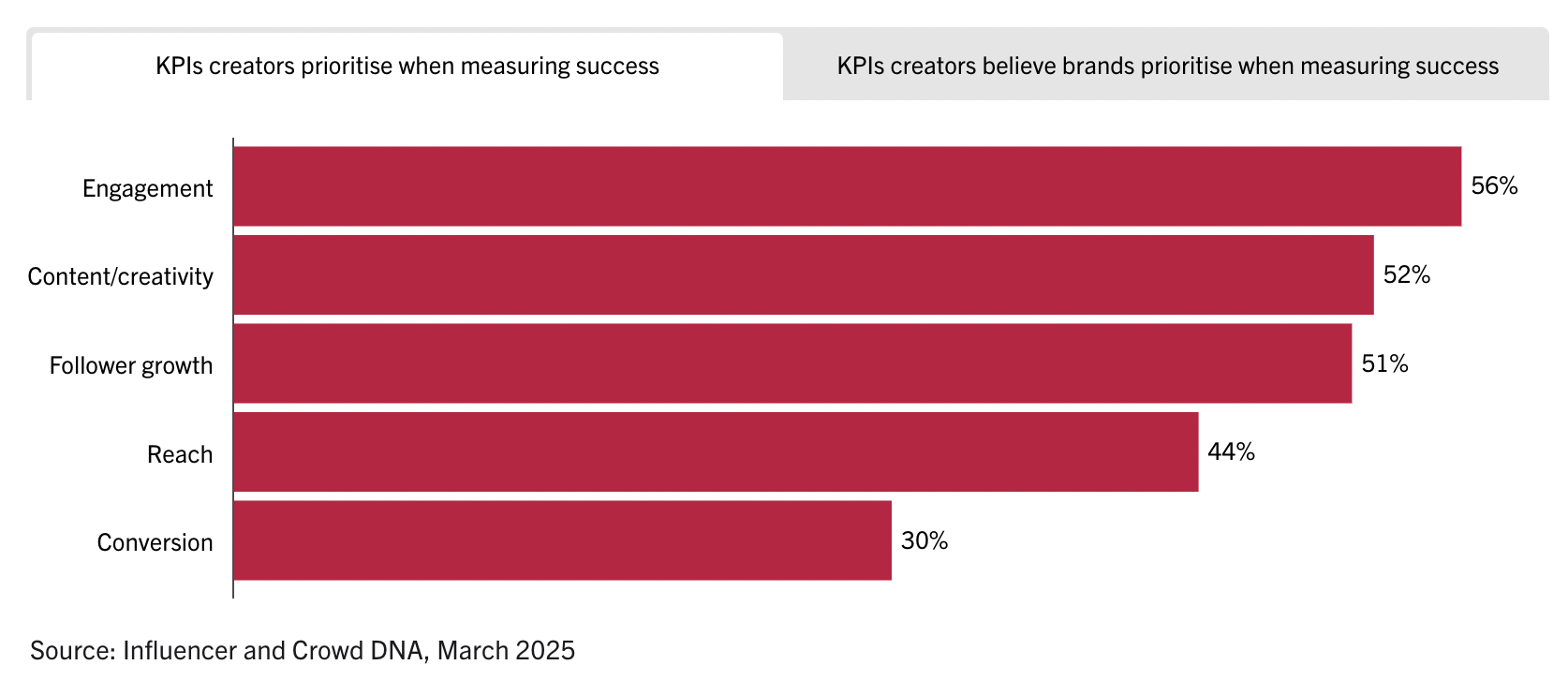 Image Source: Performance Marketing World
Image Source: Performance Marketing World
Luke Barnes, EMEA president of influencer marketing agency Influencer, pointed out that only 21% of creators prefer complete creative control. In fact, the majority of them (58%) want to be given brand guidelines to help them portray what kind of content brands actually want. “They don’t want a blank canvas. They want a map,” Barnes explained.
Further, the report also found that 39% of influencers doubt how much brands actually care about their creativity, since all they see is brands prioritize quantitative results over the quality of their work.
What can we learn from this?
Brands tend to measure a campaign’s success based on outcomes like engagement, reach, and especially sales. On the other hand, creators care more about how the content feels to themselves and their audience. Things like creativity, quality, and staying true to their voice is just as important as conversions.
This leads to a problem: many creators feel that brands don’t genuinely value their creativity, which makes the relationship feel more transactional than collaborative (even if it technically is, it still shouldn’t feel that way).
Common challenges in influencer collaborations
Other than perspectives, there are other challenges that often come up in influencer partnerships. If these issues aren’t addressed early, they can lead to misunderstandings, delays, or even failed campaigns.
Misaligned goals
This happens when brands and influencers define success differently. While they work together, they are trying to achieve something different from the same campaign. Brands may prioritize sales, while creators mostly focus on engagement or authenticity.
If that’s the case, the campaign will lack focus. What often happens is the content may feel off-brand or even forced, the audience can’t see authenticity in it, and in the worst cases, neither side is happy with the results. The brand doesn’t get ROI, and the influencer doesn’t feel proud of the content.
Unclear communication
This point is heavily related to the above. Vague briefs or the absence of agreed-upon goals often lead to confusion and avoidable mistakes. A brand might tell an influencer to create something fun or just to be themselves, but they didn’t explain what it means in context. This leaves the influencers guessing about the tone, message, or the purpose of the content.
When instructions are unclear, it’s easy for influencers to deliver something different from what the brand had in mind. And the brand isn’t satisfied with it.The next thing that can happen is revisions and approval delays, which waste time, break trust, and even damage relationships.
Luke Barnes recently said at The Future of Brands in London, “Many of us in our industry spend hours and hours talking with brands and advertisers about how they should work with creators, how to maximise their investment in them or how to measure the return on that investment. But so rarely do we invite the creators themselves to contribute to that conversation. Which is kind of insane.”
From this statement, we can see that influencers are often left out of important decisions about the very campaigns they’re a part of.
Compensation disputes
Compensation becomes a problem when brands and influencers don’t agree on what the work is worth. It could be about how much the creator is paid, how they’re paid, or when the payment is delivered. Sometimes, it’s all of those things.
The Creator Perspectives report disclosed that the number one pain point creators encounter when working with brands is payment delays, cited by 41% of respondents. This reflects ongoing issues around unclear or inconsistent payment systems. Other than delayed payments, a lack of transparency – such as what’s included in the payment and the absence of rate cards and contracts – also worsens this issue.
These problems don't only affect influencers. Brands are impacted too, as it can damage their reputation in the influencer community and makes future collaborations harder to secure. This dispute can also affect campaigns in a way that launches are delayed or public complaints may arise if an influencer speaks out.
How to align expectations between brands and influencers
Challenges always exist, but misaligned expectations can still be saved as long as both influencers and brands are open to discussion and respectful of each other. In this section, we’ll break down what can be done to align expectations and avoid the negative outcomes caused by earlier misunderstandings.
Discuss campaign details specifically before running it
According to 54% of surveyed creators, they need to understand a brand’s marketing KPIs, as it would lead to better results. 64% also expressed their willingness to learn about the measure of success according to the brand they’re collaborating with, so they can create more suitable content.
It’s not enough to simply mention what the campaign is and what kind of content you want from influencers. It’s better to provide more specific details such as brand values, campaign objectives, and your numeric targets. This way, both parties can minimize the chance of misaligned output and goals.
Caspar Lee, Co-founder of Influencer, recommended that brands include sample content during the briefing stage. He explained that giving clear guidelines helps creators shape their ideas more easily and can also reduce the chances of needing multiple rounds of revisions later on.
Set realistic goals
One of the simplest ways to prevent misalignment is to set goals that make sense for both sides. This means, brands need to ask themselves: what’s actually achievable with this campaign, on this platform, with this influencer? Remember, not every post will drive direct sales, and that’s totally fine.
For some partnerships, campaign success might look like boosted brand awareness or engagement. For others, it could be positive brand mentions and product usage shown in an influencer’s content. Setting realistic goals makes it easier for both sides to find common ground and agree on the expected outcomes from the very beginning, while also reducing the chance of frustration.
Transparent compensation agreements
Money is one of the biggest reasons trust can break down and relationships don’t last. This is why discussing compensation in a very detailed manner is important to be done before you even start a campaign. A transparent compensation agreement should clearly outline not just how much the influencer is being paid, but also what that fee covers (content creation, usage rights, exclusivity, additional edits, etc.).
Another important aspect is offering fair compensation based on influencer’s reach and effort, along with clear payment terms. Some influencers are paid 100% upfront, while others work on a 50/50 split: half upfront, half after delivery. Be sure to agree on this too since day one.
Maintain good communication
27% of surveyed influencers say their pain point is poor communication with brands. As we saw earlier, Luke Barnes said that influencers are often left out of important decisions in a campaign. What he said is a wake-up call: if brands want better outcomes from influencer campaigns, they need to treat creators as collaborators, not just content producers. That starts by giving them a seat at the table from the very beginning.
This is also echoed by Cristy Garcia, CMO at Impact.com. She believes that brands need to treat influencers as equals and true partners, rather than simply a ‘channel’ to reach their target audiences. This includes recognizing their values and respecting their creative decisions. Building good communication doesn’t just improve relationships, but also leads to better performance too.
Do regular and post-campaign review
One of the most effective ways to keep expectations aligned is by having regular check-ins throughout the campaign. These reviews allow both the brand and the influencer to stay on the same page, clear up any confusion, and make adjustments before small issues become bigger problems.
After the campaign ends, a proper review helps both sides reflect on how well their expectations matched the actual outcomes. It’s a chance to discuss what worked, what didn’t, and how to improve future collaborations.
Examples of misaligned campaigns and what we can learn from them
Misaligned campaigns are, unfortunately, very real and have happened more than once. One example we can look at is the partnership between supermodel Naomi Campbell and Adidas in June 2016. What happened was Campbell accidentally copy-pasted an internal email from Adidas into her Instagram caption instead of a polished promotional message. The email included instructions and suggested wording for the sponsored post, which said:
"Naomi, so nice to see you in good spirits!!! Could you put something like: Thanks to my friend @gary.aspden and all at adidas - loving these adidas 350 SPZL from the adidas Spezial range. @adidasoriginals"
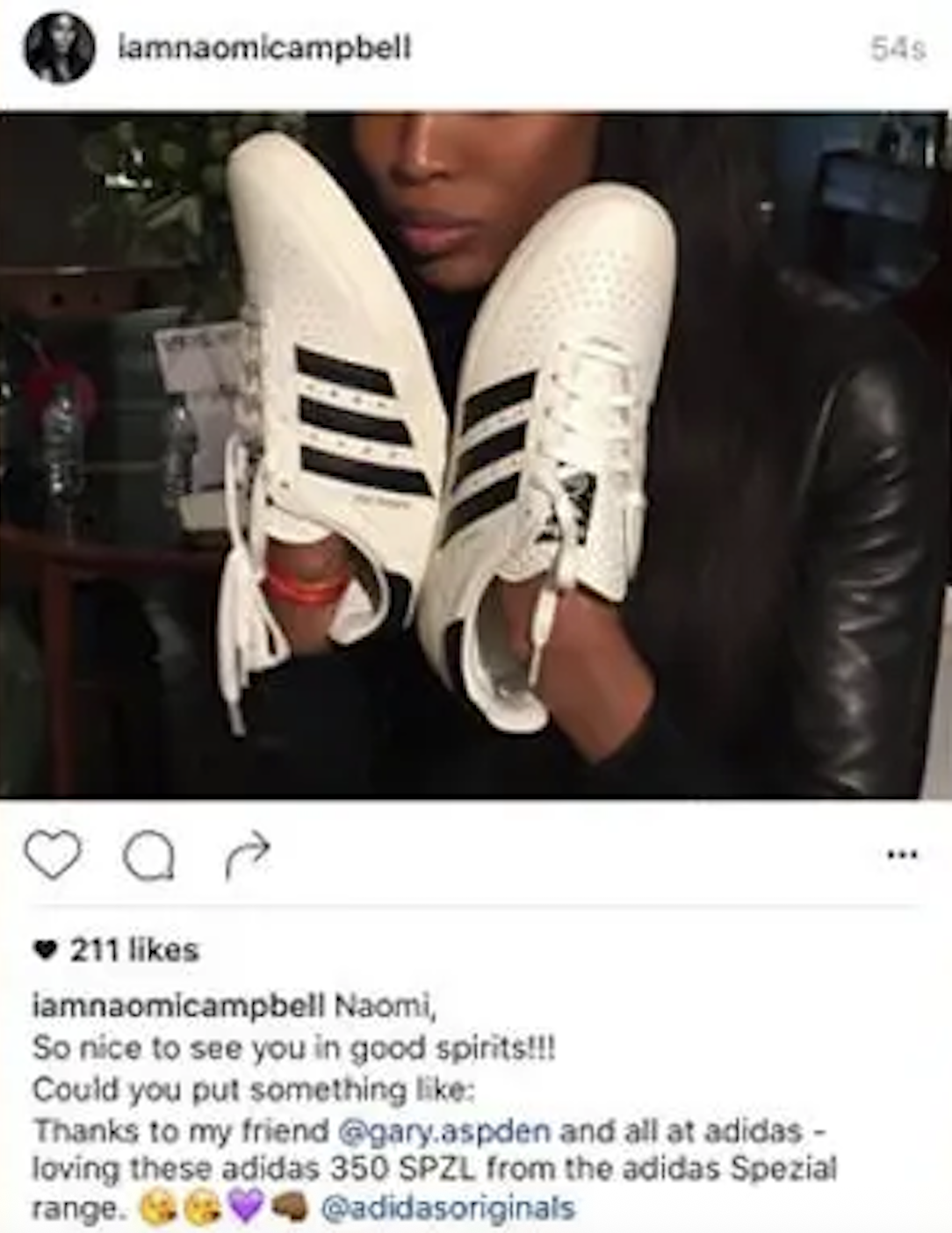 Of course, this post received heavy criticism, with people calling it “disingenuous” and “lazy”. This incident exposed the process of influencer marketing and damaged the authenticity of the endorsement. Campbell quickly edited the caption to remove the email text and replaced it with a proper message, but the error was already widely noticed and mocked online.
Of course, this post received heavy criticism, with people calling it “disingenuous” and “lazy”. This incident exposed the process of influencer marketing and damaged the authenticity of the endorsement. Campbell quickly edited the caption to remove the email text and replaced it with a proper message, but the error was already widely noticed and mocked online.
The lesson we can learn is that influencers should convey brand messages in their own style – and while this is something that’s quite obvious, this incident proves that smooth two-way communication is needed to avoid such mistakes.
Another famous case of misaligned expectations went viral in 2015, when Electronic Arts (EA) launched a major influencer marketing campaign to promote Star Wars Battlefront. They reached out to celebrities and social media personalities to endorse the game. Benjamin Burnley, frontman of the rock band Breaking Benjamin, was one of the figures approached for this campaign.
EA offered Burnley compensation to post positively about Star Wars Battlefront on his social channels. However, Burnley hated the game. Instead of going along with it, he posted a photo on Instagram of a shattered Battlefront disc, accompanied by a blunt caption:
“They wanted to pay me to post that I like this piece of sh*t game. They can shove it up their as*. This game su*ks.”
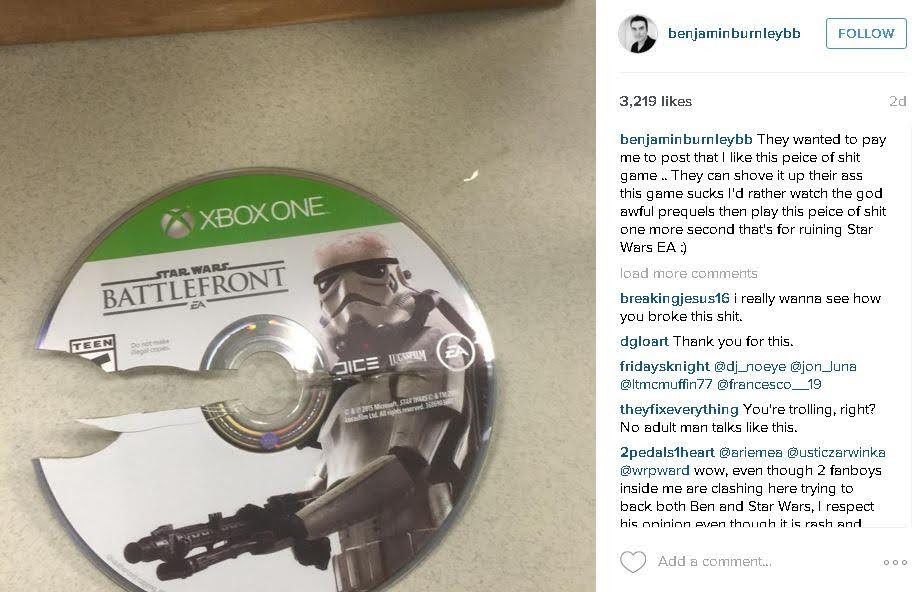 Image Source: Gamespot
Image Source: Gamespot
This caused significant embarrassment for EA and has since become a textbook example of influencer marketing gone wrong. What was supposed to be a successful collaboration instead turned into a disaster.
What can brands learn from this? Never choose influencers who don’t genuinely love your products, especially if they’re outspoken and won’t hesitate to announce their hatred to the entire world. Connection and enthusiasm can’t be faked, so brands should set realistic expectations when selecting influencers or public figures for their campaigns.
Conclusion
Influencer marketing campaigns, when done right, can be a strong driver of brand awareness, improved reputation, and increased sales. But the most successful collaborations don’t grow out of assumptions and unspoken goals. They grow through clear understanding and open communication. Brands bring their goals, influencers bring their creativity - and both need to work in sync.
When brands and influencers fail to agree on what success looks like, misaligned expectations can undo all the effort. Challenges will always exist, but they’re meant to be addressed and worked through together. At the end of the day, it’s open and honest conversation that can save your campaign.










